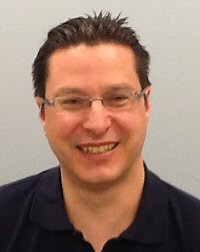Non so se Lafeuillade, nella sua folle crociata autopromozionale, si sia reso davvero conto che stava parlando di una persona in carne ed ossa, con un volto ed un nome, a cui pure aveva tenuto la sua tronfia mano sulla spalla solo pochi giorni prima davanti alle telecamere.
Sta di fatto che ora arriva la reazione di Timothy Ray Brown (non un anonimo "paziente tedesco", sciocco e vanesio dr. Çaçaçaça). E, francamente, è molto difficile dargli torto.
Le dichiarazioni di Timothy sono state raccolte da Richard Knox, per SHOTS il blog dedicato alla salute su npr.com. Tralascio il resto del post, che ripercorre brevemente la storia di Timothy, la presentazione dei dati parziali della ricerca su di lui fatta a Sitges e le ragioni della "disputa", e riporto solo la parte finale:
Traces Of Virus In Man Cured Of HIV Trigger Scientific Debate
(...) AIDS researchers — and Brown himself, in an interview with Shots — stress that even if the new findings constitute real evidence of HIV in his system, they don't mean he's not cured. Although, it's clear the findings do raise questions about what sort of cure he has.
Scientists hoped Brown had a so-called sterilizing cure — that is, the HIV has been completely eradicated from every cell in his body.
But long and bitter experience with HIV has shown that the virus can hide out in the genes of very long-lived resting immune cells. As these latently infected cells get activated over the years, HIV might reappear in the form of the whole virus or perhaps pieces of its genes.
But if that is happening in Brown, there is no evidence that the virus is actively replicating. To do that, it would need to infect other cells and hijack their genetic machinery to crank out more virus. Since Brown's replacement immune system (from the bone marrow donor) doesn't have the entry portal HIV needs, these new viruses (if they exist in his case) can't spark a new viral conflagration.
Therefore, he may be functionally cured, even if he's not totally free of HIV.
That's what Brown himself thinks may be going on, from his discussions with researchers who have been poking and prodding him for the past five years.
"With a sterilizing cure, they have to be sure that a patient is completely clear of HIV — that they've looked everywhere and can't find any," Brown says. "In my case, I still have the dead virus and it's still showing up in some ways and so I've got a functional cure." [
NdD: si attende a breve l'intervista promessa dal dr. Çaçaçaça, in cui smaschererà le balle raccontate a Timothy dai suoi medici. OMG!! 
]
To him, that's just as good.
But Brown is distressed at the suggestion by some bloggers — in particular a French AIDS researcher named Alain Lafeuillade of the General Hospital in Toulon — that he's not truly cured.
"It's not the case, but people are spreading it," Brown says. "That concerns me because I've been told by many people that I give them hope — people who have HIV. And that's what I want to do. I want to be able to continue spreading my message and be able to do that without having conflicts of people who are misinterpreting the truth."
Brown is particularly upset at suggestions that he has become reinfected with HIV through unsafe sex. "That is not the case," he says. "It's very difficult for me to listen to those things and read those things."
The latest findings are sure to be debated among AIDS researchers and advocates. Their main significance is to show how tricky it will be to determine exactly what constitutes a cure, as researchers devise various tricks to cure AIDS with less drastic means than bone marrow transplants.
The question is, when can they be reasonably sure a cure has occurred?
For his part, Brown says he'll continue to be a guinea pig for as long as it takes if he can help resolve that big question.
"Hopefully one day I won't have to do it any more," he says, because he'll just be one of many cured patients. "That would be nice." [
NdD: che Dio ti benedica, Tim, e ti conceda una vita bella e felice. Se c'è una persona al mondo che se ne è conquistata il diritto, quella sei tu. 
]



 ]
]


